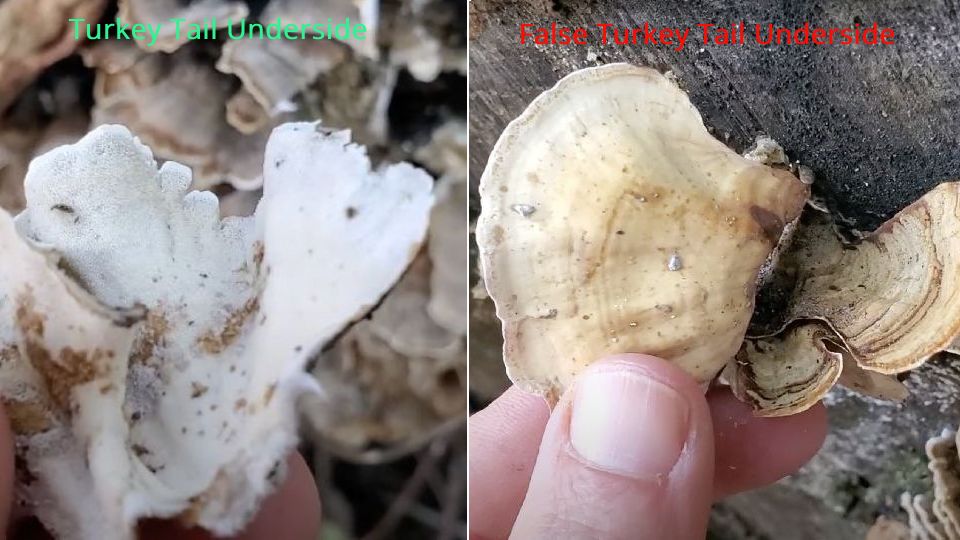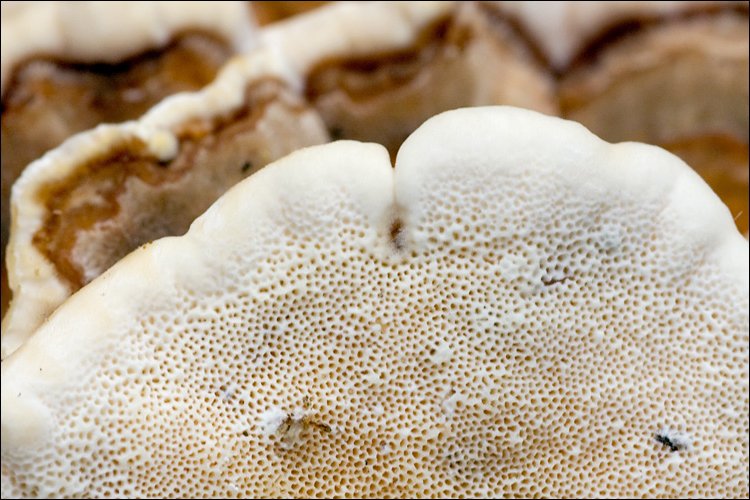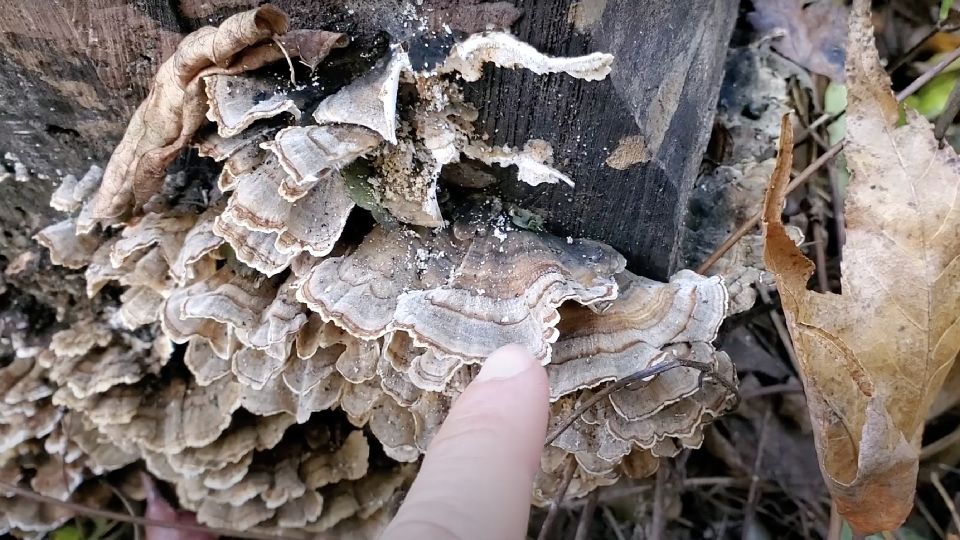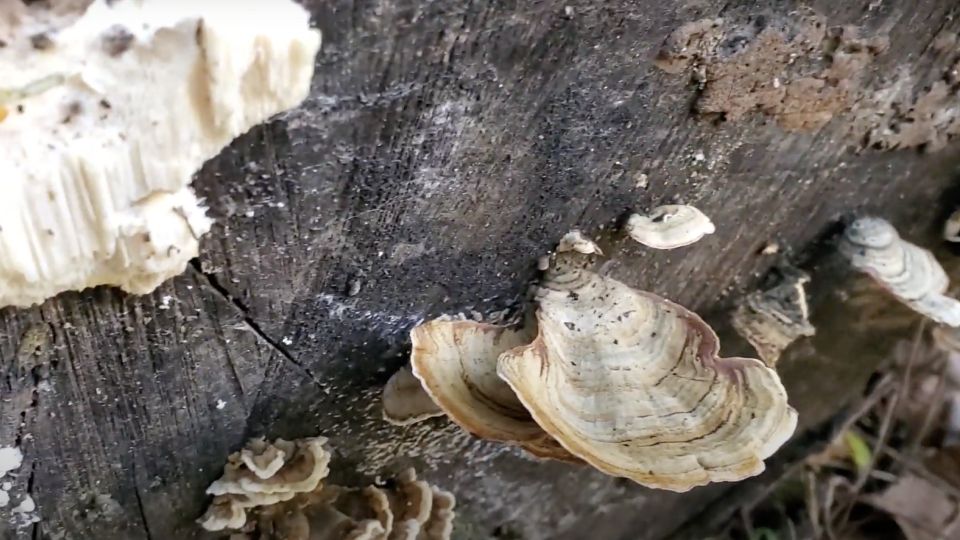False Turkey Tail Mushroom: Everything You Need to Know
You can easily confuse the false turkey tail mushroom, also known as Stereum ostrea, with the true turkey tail mushroom, called Trametes versicolor. They both thrive on decaying trees in North America and Europe. While true turkey tail mushrooms have a long history of medicinal use, the health benefits of false turkey tail mushrooms are less understood.
In this article, we’ll explore the distinctions between false and true turkey tail mushrooms. We’ll also discuss other wild mushrooms that might be mistaken for turkey tail mushrooms. By the end of this read, you’ll gain a clearer grasp of how to differentiate these fungi and learn about their potential health advantages.
In this article:
How to Identify False Turkey Tail?
When you’re identifying false turkey tail mushrooms, it’s crucial to spot some key features. Here’s what to look for:
- Underside: Check the underside of the mushroom. False turkey tail mushrooms have a smooth underside, unlike true turkey tail mushrooms, which display visible pores. Also, note that false turkey tail mushrooms have a yellow or tan underside, while the true ones are white.
- Growth: Both false and true turkey tail mushrooms grow in a shelf-like form, but there’s a difference. False turkey tail’s fruiting body is typically flat with a short or no stem.
- Color: Although both types have concentric color zones, true turkey tail mushrooms have a wide range of colors, often falling within brown to red shades. In contrast, false turkey tail mushrooms often sport a vibrant orange hue.
- Habitat: False turkey tail mushrooms grow on dead or dying hardwood trees, often in clusters or overlapping groups. They can be found in forests, parks, and other wooded areas throughout North America.
- Spore Print: To make a spore print, place a mature false turkey tail mushroom onto a piece of white paper or glass, cover it with a bowl or jar, and let it sit overnight. The spores will fall onto the paper, leaving behind a distinctive print that can help with identification. The spore color of false turkey tail mushrooms is white to pale cream.
False Turkey Tail Is The Most Common Turkey Tail Look-Alike
The Stereum ostrea is the most common Turkey Tail imposter. It grows on trees as a shelf fungus, resembling a bracket. In contrast, the Turkey Tail Mushroom is a polypore fungus with a distinct fan shape that also grows on trees. Both of these mushrooms are found in North America and are known for their medicinal properties.
“False turkey tail mushrooms can be easily confused with true turkey tail mushrooms, but their medicinal properties are not as well-known. It is crucial to accurately identify these mushrooms to avoid any potential health risks[1].”
– Mycologist Paul Stamets
False Turkey Tail vs. Turkey Tail

The table below shows the distinguishing features between False Turkey Tail and Turkey Tail[2].
| Features | False Turkey Tail (Stereum ostrea) | Turkey Tail (Trametes versicolor) |
| Fruiting bodies | Thin, flat, and shell-like, growing in clusters | Overlapping fan-shaped layers |
| Color | Bright orange to pale yellow | Dark brown to grayish hues |
| Texture | Smooth and waxy | Woody and tough |
| Underside | Smooth and lacking pores | Porous with tiny pores that release spores |
| Size | Typically smaller, 1-5 cm in diameter | Can range from a few centimeters to over 10 cm in diameter |
| Medicinal Properties | Contains some bioactive compounds but is not typically used for medicinal purposes and is not as effective as turkey tail mushrooms | Contains bioactive compounds such as beta-glucans, triterpenoids, and polysaccharides that have potent immunomodulatory effects and is commonly used to boost the immune system, fight infections, and reduce inflammation |
| Toxicity | Considered to be safe for consumption and sometimes used in culinary dishes | Generally safe to consume when used correctly |
Watch the Video on How to Identify the Two
What Are the Key Identification Features of Turkey Tail Mushrooms?
The following five-step process will help to ensure you correctly identify Trametes versicolor, commonly known as turkey tail mushrooms:
1. Look for them on oak trees – This mushroom prefers to grow on dead or decaying hardwood trees, especially oak. If you are searching for them in the wild, start by looking for them on oak trees or fallen logs.
2. Check the underside of the mushroom – The tiny pores on the underside of the turkey tail mushroom can be a key identifying feature. Use a magnifying glass to get a closer look and count the number of pores per millimeter. The pores on the underside of the mushroom are typically small, ranging from 2-3 pores per millimeter in size.

3. Observe the colors and patterns – The concentric rings of different colors on the upper surface of the turkey tail are a distinctive feature. Look closely at the colors and patterns to help identify the species. Some of them have more muted colors, while others have bright and vibrant hues.
4. Examine the texture – Turkey tail mushrooms have a tough and leathery texture, which sets them apart from other, softer mushrooms. Touch and feel the mushroom to get a sense of its texture.
5. Consider the season – They are most commonly found in the fall, but can also be found in the spring and summer. Keep in mind the time of year when searching for them, as this can help narrow down the potential species.
What Other Wild Mushrooms Are Misidentified as Turkey Tail?
Several wild mushrooms are commonly misidentified as Turkey Tail. The table below outlines the key differences and similarities between Turkey Tail (Trametes versicolor), False Turkey Tail (Stereum ostrea), Violet Toothed Polypore (Trichaptum biforme), and Gilled Polypore (Trametes betulina).

| Mushroom Name | Differences from Turkey Tail | Similarities to Turkey Tail |
| False Turkey Tail (Stereum ostrea) | Has a smooth top surface without concentric rings, and lacks the tiny pores on the underside. Instead, it has a smooth or slightly wrinkled underside with a creamy-white to light brown color. | Grows on hardwood trees and has a similar texture to Turkey Tail. |
| Violet Toothed Polypore (Trichaptum biforme) | Has a violet-brown spore print, tooth-like structures on the underside instead of pores, and a smooth top surface with wavy edges. | Also grows on dead hardwood trees and has a tough, woody texture. |
| Gilled Polypore (Trametes betula) | Has gills instead of pores on the underside, a white to cream-colored cap, and lacks the concentric rings of color on the top surface. | Grows on hardwood trees, and has a tough, leathery texture similar to Turkey Tail. |
SUMMARY
While these mushrooms share some similarities with Turkey Tail, they also have distinct differences in their appearance and characteristics. When identifying wild mushrooms, it’s always best to consult a reputable field guide and/or an experienced mushroom identifier.
Where to Find Turkey Tail Mushrooms?
Turkey Tail mushrooms (Trametes versicolor) can be found in various parts of the world. You may come across them in the following places:
- Natural habitats: Turkey Tail mushrooms grow on decayed trees, branches, and stumps. You can search for them in forests and wooded areas, particularly on oak and hardwood trees.
- Local farmers’ markets: Numerous farmers’ markets offer fresh or dried mushrooms, including Turkey Tail.
- Health food stores: Several health food stores provide Turkey Tail mushrooms in the form of capsules or extracts as a dietary supplement.
- Online vendors: Various online retailers sell Turkey Tail mushrooms in different forms, including fresh, dried, capsules, and extracts. It’s essential to purchase from a reliable source.
If you plan to hunt for Turkey Tail mushrooms in the wild, you should conduct thorough research and understand how to correctly identify them, as well as any mushrooms that may resemble them and be toxic. Sustainable harvesting practices must be observed, and some mushrooms should be left behind to preserve the ecosystem’s health.
What is False Turkey Tail Good For?
Initial studies have suggested that false turkey tail mushrooms (Stereum ostrea) may possess some health-promoting properties. In vitro research published in the International Journal of Medicinal Mushrooms has indicated that extracts from false turkey tail mushrooms have significant anti-inflammatory activity, potentially making them a natural anti-inflammatory agent.
Furthermore, another study published in the Journal of Medicinal Food has found that false turkey tail mushrooms have significant antioxidant activity, which can help defend cells against oxidative damage from free radicals[3].
However, more research is necessary to determine the full extent of the potential health benefits of false turkey tail mushrooms.
Does False Turkey Tail Have Medicinal Properties?
The tough texture of false turkey tail mushrooms means they’re not suitable for humans to eat. Nevertheless, a study did find that extracts from false turkey tail do possess certain antibacterial and antifungal properties, even though they may not provide the remarkable benefits of true turkey tail mushrooms.
Using a false turkey tail as a medicine is not recommended due to the risk of nausea, vomiting, and other gastrointestinal problems. Additionally, since it can grow on contaminated wood, it may expose you to harmful substances.
NOTE
Although false turkey tail has medicinal potential, more research is necessary before it can be safely recommended as a treatment. Until then, it is best to avoid consuming this fungus.
What Are the Health Benefits of Turkey Tail Mushrooms?

For centuries, people have used turkey tail mushrooms for their immune-boosting properties. Extensive research has been conducted on turkey tail mushrooms, indicating that they contain potent polysaccharides that can stimulate the immune system and possess anti-cancer effects[4][5].
One study found that they may enhance the immune response in people with weakened immune systems, while another study showed that they can improve the immune function of breast cancer patients undergoing chemotherapy[6]. A review article further highlights the potential therapeutic benefits of turkey tail mushrooms, including their anti-inflammatory and antioxidant activities, as well as their anticancer and antimicrobial properties[7].
NOTE
It is crucial to seek advice from a healthcare professional before using turkey tail mushrooms or any other natural remedy or supplement. Although turkey tail mushrooms may have health benefits, it is essential to ensure that they are used safely and properly.
Turkey Tail Mushrooms Side Effects
Turkey tail mushrooms are generally safe to consume if used properly. However, like any other food or supplement, they may cause side effects in some individuals.
Mild gastrointestinal side effects such as nausea, bloating, or diarrhea may occur in some individuals after consuming turkey tail mushrooms. These side effects usually resolve on their own and are not serious.
It is important to note that turkey tail mushrooms can potentially interact with certain medications, such as blood thinners or immunosuppressants. Thus, individuals who take these medications or have underlying health conditions should avoid consuming turkey tail mushrooms.
FAQs
Are There Toxic Look-Alikes for Turkey Tail?
Turkey tail mushrooms do not have any toxic look-alikes. However, Some mushrooms bear a resemblance to turkey tail mushrooms but lack the beneficial compounds that make turkey tail mushrooms unique. It’s important to note the distinction to ensure you’re getting the health-supporting properties associated with turkey tail mushrooms.
What’s the Best Way to Take Turkey Tail Mushrooms?
The best way to take turkey tail mushrooms is to take them as a dietary supplement. This can be done in the form of capsules, powders, or extracts. Studies have shown that taking turkey tail mushrooms as a dietary supplement can help to strengthen the immune system, reduce inflammation, and fight off infections. Taking turkey tail mushrooms in this form allows for an easier and more consistent dosage.
Is the False Turkey Tail Poisonous?
No, the false turkey tail is not poisonous. While the false turkey tail may look similar to the turkey tail, it is not a poisonous mushroom. This mushroom is found in the same family as the turkey tail, but it is not toxic and is not considered a medicinal mushroom.
Is it Safe to Take Turkey Tail Every day?
It is generally considered safe to take turkey tail mushrooms daily. However, it is important to consult with a healthcare professional before taking any supplement or medicinal mushroom regularly. Different people may have different health needs and a healthcare professional can help to determine the best dosage and frequency for taking turkey tail.
Is False Turkey Tail Mushroom Edible?
Yes, false turkey tail mushrooms are edible. False turkey tail mushrooms are edible, but they do not have the same medicinal properties as turkey tail mushrooms. False turkey tail can have a bitter taste and may not be as enjoyable to eat as the turkey tail mushroom.
How to Prepare Turkey Tail Mushroom?
To prepare turkey tail mushrooms, it is best to first clean them by brushing off any dirt and debris. They can then be sliced into thin slices or diced into small cubes. Turkey tail mushrooms can be cooked in a variety of ways including sautéing, stir-frying, boiling, steaming, or even roasting.
Are Turkey Tail Mushrooms Edible?
Yes, turkey tail mushrooms are edible and can be enjoyed as part of a healthy diet. Turkey tail mushrooms are a type of medicinal mushroom that is known for its immune-boosting properties. They can be consumed raw, cooked, or taken in supplement form. Turkey tail mushrooms are a great source of fiber, protein, and a variety of vitamins and minerals.
Conclusion
In conclusion, this comprehensive guide has shed light on the false turkey tail mushroom, providing valuable information and insights for those seeking to understand this intriguing species. By examining its appearance, habitat, and potential health benefits, we have gained a deeper understanding of the false turkey tail’s distinguishing features and its significance in the natural world.
Throughout this exploration, we have emphasized the importance of accurate identification and consulting experts in the field to avoid any confusion or adverse consequences. As with any mushroom foraging, it is vital to exercise caution and adhere to ethical practices.
References:
1. Stamets, P. (2017). Mycelium Running: How Mushrooms Can Help Save the World. Ten Speed Press. Retrieved from https://www.amazon.com/Mycelium-Running-Mushrooms-Help-World/dp/1580085792
2. Optimization of exopolysaccharide synthesys by medicinal fungus Trametes versicolor in submerged culture. Retrieved from https://www.researchgate.net/publication/354662948_Optimization_of_exopolysaccharide_synthesys_by_medicinal_fungus_Trametes_versicolor_in_submerged_culture?_sg=jct8A5sY2ur0dcrCvP2eZA8A99UAuMgL-8_FeUBsWo2YTjRrHwt5BWZTAihCQGB-KQuRhbeIklkKrX0
3. Production of cellulolytic enzymes by a mushroom-stereum ostrea. Retrieved from https://www.researchgate.net/publication/265152865_Production_of_cellulolytic_enzymes_by_a_mushroom-stereum_ostrea
4. The mycelium of the Trametes versicolor (Turkey tail) mushroom and its fermented substrate each show potent and complementary immune activating properties in vitro. Retrieved from https://www.ncbi.nlm.nih.gov/pmc/articles/PMC6889544/
5. Polysaccharide-Peptide from Trametes versicolor: The Potential Medicine for Colorectal Cancer Treatment. Retrieved from https://www.researchgate.net/publication/365238685_Polysaccharide-Peptide_from_Trametes_versicolor_The_Potential_Medicine_for_Colorectal_Cancer_Treatment
6. Coriolus (Trametes) versicolor mushroom to reduce adverse effects from chemotherapy or radiotherapy in people with colorectal cancer. Retrieved from https://www.researchgate.net/publication/365843743_Coriolus_Trametes_versicolor_mushroom_to_reduce_adverse_effects_from_chemotherapy_or_radiotherapy_in_people_with_colorectal_cancer
7. Antioxidative, antifungal, cytotoxic and antineurodegenerative activity of selected Trametes species from Serbia. Retrieved from https://www.ncbi.nlm.nih.gov/pmc/articles/PMC6118373/

